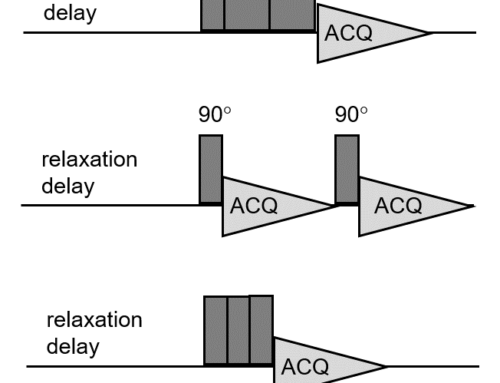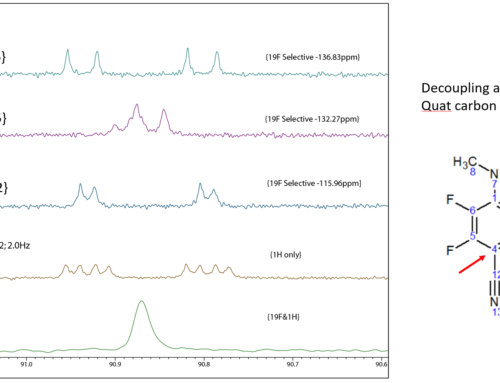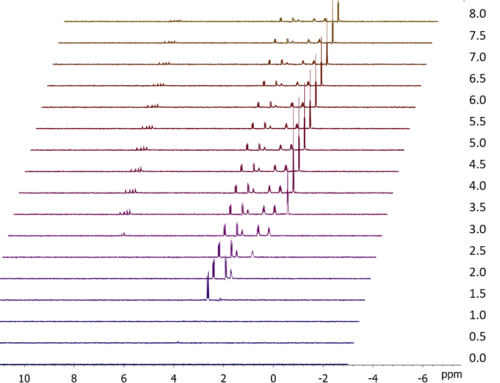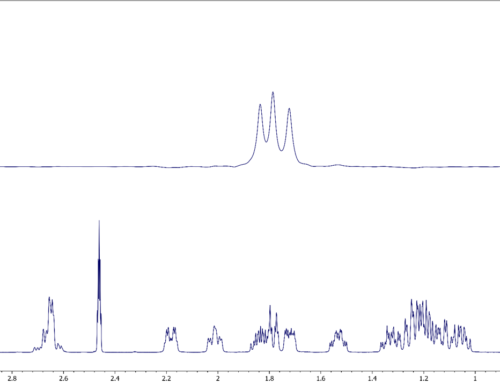Over the next few posts, I’m going to delve a little deeper into pure shift NMR experiments and show how to adjust the parameters to get the best results. Understanding the effect the different parameters have upon the final spectrum is very important and can really make the difference between getting a poor pure shift spectrum and getting a great one.
Sensitivity in Zangger-Sterk spectra
In my last post, I showed how it’s possible to run the Zangger-Sterk experiment as a band-selective experiment instead of the more conventional “slice-selective” one. As I explained, the principal advantage of band-selective acquisition is we avoid the very large penalty in sensitivity that is incurred by running in slice-selective mode. However, the trade-off with band-selective acquisition is we don’t obtain a full pure shift spectrum. With pure shift NMR experiments, it’s a case of choosing the most appropriate tool for the job at hand. Fortunately, if a full pure shift spectrum is what you really need, it’s possible to minimize the sensitivity loss, simply by taking care with setting a few experiment parameters.
Zangger-Sterk basics
Pure shift experiments utilize different building blocks that are specifically designed to decouple the spins we observe (the “active” spins) from their J-coupled partners that we do not observe (the “passive” spins). These building blocks are often referred to as active spin refocusing (ASR) elements, and different pure shift experiments are based around different ASRs, each with their own particular benefits and drawbacks. I won’t go into the details of how ASRs work here, but interested readers can find out more by checking out my pure shift webinar. In the case of the Zangger-Sterk experiment, the ASR element consists of a band-selective RF pulse in the presence of a weak field gradient (Figure 1). Typically, a RSNOB pulse is used, but other pulse shapes are sometimes used.

Figure 1. Zangger-Sterk active spin refocusing (ASR) element
The key to getting the best out of the Zangger-Sterk experiment is appropriate adjustment of both the shaped pulse and the field gradient in the ASR. Let’s explore each of these in turn, using a sample of 2-ethyl-1-indanone to illustrate.
Adjusting the selective pulse bandwidth
To get a good Zangger-Sterk pure shift spectrum, i.e. one where all the homonuclear splittings have been removed, the bandwidth of the selective pulse needs to be less than the minimum frequency separation of two mutually coupled signals. To try to make this very important point a little clearer, consider the aromatic region of 2-ethyl-1-indanone (Figure 2). The two asterisked peaks, which are around 60 Hz apart, are due to the mutually coupled protons indicated in rectangles.

Figure 2. Full 1H spectrum of 2-ethyl-1-indanone and (inset) aromatic region. The data were collected on a JEOL ECZ-500 spectrometer equipped with a ROYAL-HFX probe and running Delta 6.0 software. The data were processed automatically using JASON software
So let’s look at how the bandwidth of the selective pulse affects the quality of the pure shift spectrum. I collected three different pure shift spectra, each with identical parameters except the bandwidth of the selective pulse. Each pure shift spectrum was collected in 8 minutes using the pureshift_1d_zs.jxp pulse program using 4 scans and 32 increments. The data were automatically processed using the JASON software with no manual adjustment of the processing required.
Wide selective pulse bandwidth
Figure 3 illustrates what happens if we collect a spectrum using a selective pulse with a bandwidth that is too wide. As we can see, the two asterisked peaks are not clean singlets. In fact, the two peaks are a mixture of the desired pure shift singlet and a J-modulated doublet due to the coupling between these two protons.

Figure 3. Zangger-Sterk spectrum of 2-ethyl-1-indanone, obtained using a 70 Hz-wide shaped pulse. The decoupling of the two asterisked protons is incomplete because the bandwidth of the selective pulse is greater than the separation of the two peaks
Optimum selective pulse bandwidth
Now let’s see what happens if we reduce the bandwidth of the pulse to a little less than the separation of the two peaks (Figure 4). We now obtain a clean pure shift spectrum, with no peak splittings.

Figure 4. Zangger-Sterk spectrum of 2-ethyl-1-indanone, obtained using a 45 Hz-wide shaped pulse. The aromatic region shows singlets for all the peaks.
Narrow selective pulse bandwidth
So why not just set the bandwidth of the selective pulse to be very narrow in the first place, to ensure that we get good decoupling? As you’ve probably guessed by now, the answer comes down to sensitivity. Reducing the bandwidth of the selective pulse reduces the width of the slices from which we detect our “active” spins, which in turn reduces the peak intensities in our Zangger-Sterk spectrum. If we want the highest sensitivity in our spectrum, we need to take care not to go too narrow with the bandwidth of our selective pulse. Figure 5 shows a Zangger-Sterk spectrum that was collected using a 15 Hz-wide pulse, which is somewhat narrow compared to the 60 Hz peak separation in the spectrum. As you can see, the signal-to-noise in spectrum is significantly lower than in the spectrum in Figure 4, due to the lower peak intensities.

Figure 5. Effect of using an excessively narrow pulse bandwidth. A 15-Hz wide pulse was used, which is significantly less than is required given the minimum ca. 60 Hz separation of the mutually coupled (asterisked) peaks in the spectrum
Conclusions
In this post, I’ve showed how to set the bandwidth of the selective pulse in the Zangger-Sterk pure shift NMR experiment to get good results without unnecessarily sacrificing sensitivity. Next time, I’m going to look at how to adjust the gradient amplitude in the ASR element to deliver further improvements in sensitivity. In the meantime, to find out more about pure shift experiments and how they can help you, let us know!
And why not try JASON software for yourself and discover how its advanced data processing and analysis tools make it easy to get great results from pure shift and many other NMR datasets.




